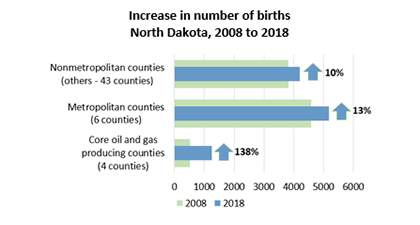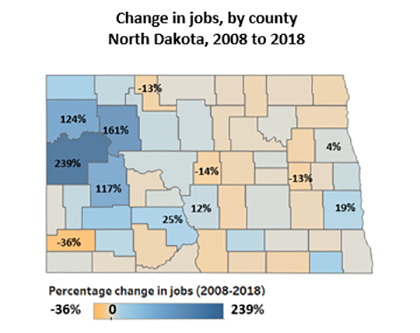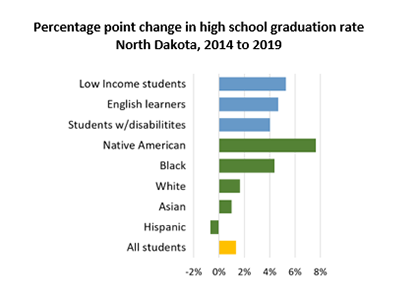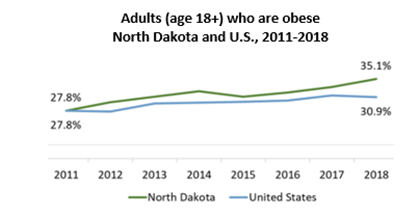Ask A Researcher
March 2020
2020 Compass Points: Measuring Progress. Inspiring Action.
North Dakota Compass provides and promotes the use of reliable, accurate, and unbiased demographic, economic, and socio-economic data to support informed decision-making and community engagement in North Dakota. The North Dakota Compass team promotes the use of quality data through presentations, workshops, newsletters, and social media. This article highlights the notable trends and data points that appear in the newly released 2020 Compass Points.
North Dakota Compass (ND Compass) just launched its signature publication, the 2020 Compass Points. The annual indicator report includes data and analysis about notable trends, key demographics, and a dashboard look at measures of progress in key topic areas in North Dakota. The Compass Points captures the current state of North Dakota, the state in relation to other states, and measures progress over time. The report uses the most recent data published by national data sources such as U.S. Census Bureau, U.S. Bureau of Economic Analysis, U.S. Bureau of Labor Statistics, as well as local, state specific data sources like ND Department of Public Instruction, ND Department of Health, ND Secretary of State, and ND Job Service. The goal of this publication is to provide data and analysis to better identify and build understanding about the issues and opportunities facing the state of North Dakota.
Key Trends
The most notable trends highlighted in this year’s report are:
1. Economic development had a substantial impact on the number of births in the past decade.

Rapid growth in the oil and gas sector coupled with diverse urban economic development has attracted young people to North Dakota. This increase in the young population has led to an increase in the number of births statewide from 8,931 in 2008 to 10,630 in 2018.
The number of births more than doubled in the four core oil and gas producing counties (721 more births or 138% increase). Metropolitan counties also experienced an increase of 585 births (13%) from 2008 to 2018. This trend has not been consistent throughout the state. While the remainder of the state increased the number of births by 393 (10%) overall, 17 counties experienced a decrease in the number of births from 2008 to 2018. The increase in the number of births has multiple ramifications as communities address current and future demand for child care, youth programs and activities, and schools.
2. Jobs creation in North Dakota far outpaced national averages but workforce challenges persist.

The number of jobs in North Dakota has increased by 19 percent from 2008 to 2018, outpacing national job growth of 8 percent. The number of jobs increased by 117 percent to 239 percent in core oil and gas producing counties and 4 to 25 percent in metropolitan areas. However, 25 rural, sparsely populated counties lost jobs during the same time period.
Filling open jobs has been challenging. Unemployment rates statewide remain some of the lowest in the country (2.6 % in 2018) and workforce participation rates (percentage of adults, age 16-64, who are working) remain among the highest (78.8% in 2018). All North Dakota’s counties reported more job openings than active résumés (0.27 active résumés per job opening overall), in January 2020.
3. Most historically disadvantaged students showed progress in on-time high school graduation rate.

Most student groups in North Dakota saw an increase in on-time high school graduation rate in the past five years. Native American students, who have the lowest graduation rate among racial and ethnic groups (72.2%), posted a 7.6 percentage point increase in graduation rate from 2014 to 2019. During the same time period, the graduation rate for black students increased 4.4 percentage points. Among other groups, the graduation rate also increased for low income students, English learners, and students with disabilities (5.3, 4.6, and 4.1 percentage points, respectively).
While progress for the most historically disadvantaged student groups is notable, substantial disparity in graduation rates exists between students with a disadvantaged status and their counterparts.
4. The North Dakota adult obesity rate increased to the 8th highest in the nation.

In 2011, 27.8 percent of North Dakota’s adults (age 18 and older) were obese, ranking North Dakota 25th among the 50 states. Seven years later, in 2018, the adult obesity rate rose to 35.1 percent, raising North Dakota's ranking to the 8th highest in the nation.
The North Dakota obesity rate has trended above the national average since 2011.
State of the State Dashboard
In addition to the main trends, a dashboard provides key metrics in all topics on the ND Compass website, highlighting how North Dakota compares to other states and how the state is trending.
In 2018, North Dakota ranked first among the 50 states for…
- Lowest percentage of households who are cost-burdened from housing (22.8%)
- Real compound annual growth rate of GDP (4.3%)
North Dakota ranked among the top 5 states for…
- The percentage of babies born at low birth weight (6.6% - 2nd lowest)
- The percentage of the civilian population (age 16-64) who are employed (78.8% - 2nd highest)
- The percentage of older adults (age 65 and older) who volunteer (41.1% - 3rd highest)
North Dakota ranked among the bottommost states for…
- The percentage of children (3 and 4 years old) enrolled in preschool (37.2% - rank 48 out of 50 states, from highest to lowest percentage)
Compared to the previous year, North Dakota significantly improved on ...
- Percentage of children enrolled in preschool (increased from 29.4% in 2017 to 37.2% in 2018)
- Percent of eligible voters who voted in the midterm election (increased from 43.8% in 2014 to 57.8% in 2018)
- Annual change in real Gross Domestic Product (GDP) (from 0.0% change in 2017 to 3.6% increase in 2018)
- Third grade students proficient in reading (increased form 46.0% in 2018 to 48.0% in 2019)
- Eight grade students proficient in math (increased from 44.0% in 2018 to 47.0% in 2019)
- Total nonfarm payroll jobs (increased from 430,800 in 2017 to 433,400 in 2018)
Compared to the previous year, North Dakota trended unfavorably on ...
- Older adults (age 65 and older) with a disability (increased from 30.4% in 2017 to 33.4% in 2018)
The North Dakota by Numbers section on Compass Points features notable data points in demographics, economy, health, civic engagement, and workforce. Among the data highlighted are:
- Increase in the population of color in North Dakota from 2010 to 2018 (64% increase in North Dakota as compared to 16% in the U.S.)
- North Dakota was the only state in 2018 with a median age younger than in 2010 (35.2 years)
- Increase in the median household income in North Dakota from 2000 to 2018 (20%), the largest percentage increase of any state
- Increase in number of children (age 0-17) from 2010 to 2019 (20%), the largest percentage increase of any state
- Poverty rate by county ranges from 7% to 33%.
Data for the 2020 Compass Points is provided by North Dakota Compass with the most recent data updated in February 2020. Data sources, years, margins of error, and additional notes are available on ndcompass.org.
Download the 2020 Compass Points.
Browse ndcompass.org for more actionable data and trends.
.png)
